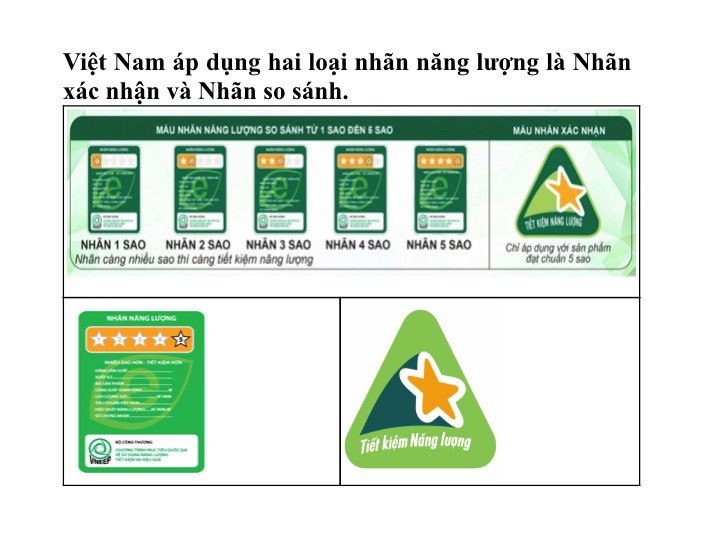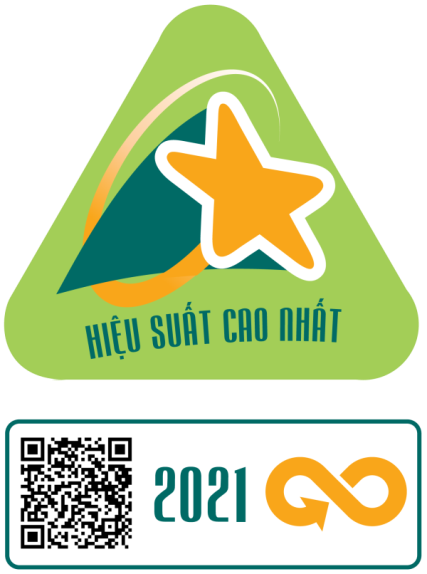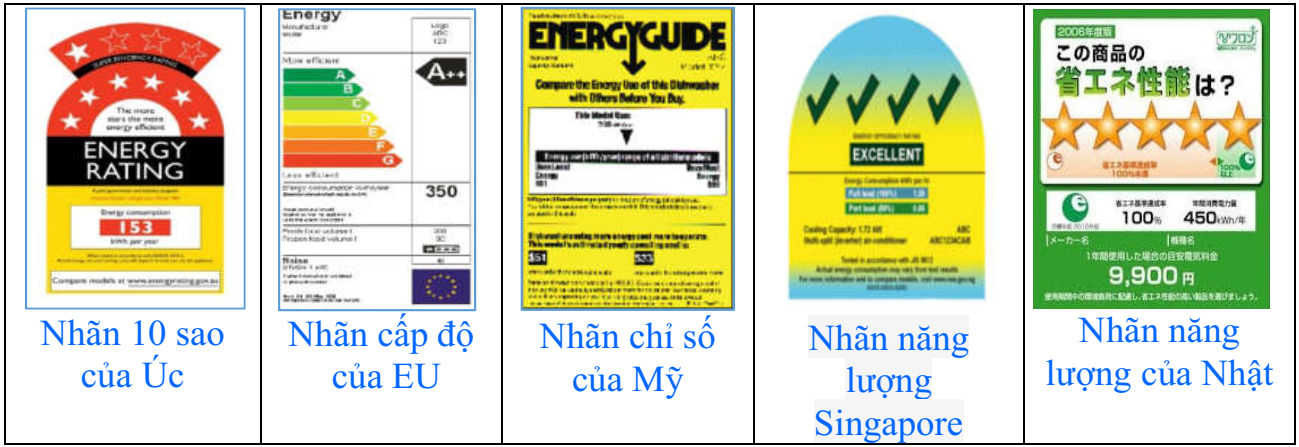In order to meet the rapidly increasing energy demand, especially the demand for electricity consumption, together with the development of power supply it is necessary to promote the implementation of solutions to use energy economically and efficiently. One of important solutions is to implement energy labeling for energy-using equipment, focusing firstly on devices that consume a lot of electricity, commonly used in the market and resulted significant impact on load graph etc. The energy labeling program has been started since 2006 (by voluntary form) and is mandatory according to the roadmap for many equipment from July 2013. The goal of the program is towards applying more efficient equipment, reducing power consumption and greenhouse gas emissions, saving the investment capital that may be intended for building new power plants. This article summarizes the current status of energy labeling activities in Vietnam, proposes orientation of basic solutions for promoting efficient use of energy in production and consumption and saving natural resources.
Current status of energy labeling in Vietnam
According to statistics and forecasts, the demand for electricity is always growing at a high rate (an average increase of about 10% per year in the period 2011-2020 and forecasted from now to 2030, after each 5-year period, electricity demand will increase by 1.5 times).To meet such demand, the energy sector is not only under pressure in terms of equipment, technology and operation, but also great pressure on investment capital. The total investment capital demand for the power sector which was implemented in the period 2011-2018 was calculated at about 818,000 billion VND (average 102,000 billion VND/year). According to the newly added and updated draft Power Master Plan VIII, for selected option (ie. increasing the current capacity from 69,258 MW in 2020 to 102,193 MW in 2025, 137,662 MW in 2030, 276,601 MW in 2045), the investment capital requirement for the power sector is calculated at about 12.8 billion USD/year for the period 2021-2045, which means about 320 billion USD for the whole period.
Therefore, for Vietnam as well as for all countries in the world, energy production always needs to go hand in hand with energy saving to ensure sustainable development. If this principle is not enforced, no matter how great the resource and financial potential, it will go to the depletion stage, and at the same time, many consequences of pollution and ecological imbalance, economical instability etc. will occur.
In the national strategy for sustainable development of the national energy sector, the energy labeling is considered a very necessary measure to put energy policy directions into practice on a nationwide scale, gradually reduce and eliminate means and equipment of outdated technology, reduce energy intensity in production and use energy efficiently in all socio-economic activities.
In the field of economical and efficient use of energy, a system of legal documents has been issued, forming a relatively complete legal framework in the direction of unified management of activities; specifying sanctions on management of activities in the program (ie. on application of energy efficiency standards and energy labeling for energy-intensive and popular means and equipment in daily life); specifying the implementation schedule. First of all, the Law on Economical and Efficient Use of Energy clearly states in Article 5, Clause 4: “Encouraging the use of energy-saving devices and equipment; implementing the roadmap to apply energy labeling; gradually eliminating means and equipment with outdated technology and low energy efficiency” and in Article 39: regulations on energy labeling. Decree 21/2011/ND-CP of the Government dedicates Chapter V including 10 articles which regulates energy labeling for energy-using means and equipment. In this field, more than 20 legal documents have been issued at the macro level (including Decrees of the Government, Decisions of the Prime Minister and Circulars of relevant ministries), together with 3 National Programs, 30 set of MEPS Standards applicable to target groups of equipment, 07 Decisions on Designation of Test Agencies, 16 other guiding documents.
Energy labeling activities are directed uniformly across the country according to the "Program on developing energy efficiency standards and energy labeling" (hereafter referred to as the Program). Implementation of the Program is like an arrow hitting many targets: (1) Technically and technologically, its aim is to apply new technologies in production, make high-performance, energy-saving and environmentally friendly equipment, gradually remove from the market means and equipment with outdated technology, reduce energy intensity in production, save energy in all socio-economic activities; (2) Regarding trade, import and export, implementing energy labeling will put pressure on importers and traders of equipment to choose products that meet or exceed the prescribed energy efficiency standards and ensure the parameters stated on the label, contribute to market orientation, help consumers to choose the right energy-saving products with increasingly advanced energy efficiency; (3) In terms of saving results, tens of millions of high-efficiency energy-using devices and products in industry and civil will bring great savings and high economic efficiency to the whole society.[1]
Energy labeling activities in Vietnam have been implemented in a voluntary manner since 2006 and compulsory (for some means and equipment) from July 1, 2013. Although Vietnam was in few decades behind developed countries, thanks to inheriting and drawing valuable lessons from experienced countries and applying it appropriately to Vietnam's situation, the Energy Labeling Program has achieved significant achievements. Statistics of the Energy Saving Program show that by 2020, nearly 20,000 product codes including 25 types of equipment have been labeled with energy from 1 star to 5 stars. The Program contributes to removing about 45 million incandescent light bulbs (over 40W) annually from the market, improving the efficiency of many popular electricity consuming products including transformers, air conditioners, rice cookers, electric fans, fluorescent tubes, compact lamps, etc.
Sold household appliances with energy labels such as electric fans, television sets, air conditioners and household refrigerators are accounted for 90-95% of total products in the market. For air conditioning products alone, it is estimated that the annual amount of saved electricity (as consumers switch to buying and using high-efficiency air conditioning products) is more than 100 million kWh/year. The savings of refrigerator products are also significant. In general, the amount of electricity saved from energy-labelled products will reach about 10% by 2020 and this figure is forecasted to increase to 30% by 2030 if the Program is drastically implemented with internal resources and effective support from international organizations.

Vietnam is applying two types of energy labels: Confirmation Label and Comparative Label. A confirmation energy label is a label affixed to marketed products and equipment whose energy use level meets or exceeds energy efficiency performance levels, ie. reaching or exceeding high energy efficiency levels (HEPS). A comparative energy label is a type of label that compares the energy performance of a labeled product against the minimum energy efficiency level specified in the energy efficiency standard (ie. the performance level achieved by the product compared to the energy efficiency level of MEPS). Comparative labels are compulsorily required by category and the roadmap which is regulated over time in accordance with technological progress and popularity in the market.
Decision 04/2017/QD-TTg that takes effect from April 25, 2017 stipulates the list of means and equipment which are subject to energy labeling and applying minimum energy efficiency. Those means and equipment consist of 4 groups, including: (1) Group of household appliances, (2) Group of office and commercial equipment, (3) Group of industrial equipment, (4) Group of transport means.
From the perspective of macro management, in the process of implementing the Energy Labeling Program, relevant State management agencies have made timely adjustments, amendments and supplements to legal documents that need to be updated for simplifying the energy labeling licensing process, creating favorable conditions for producers and consumers. A typical example is that in 2016 the Ministry of Industry and Trade made a big step in administrative reform in this area. MOIT had issued the Circular 36/2016/TT-BCT regulating energy labeling for energy-consuming means, equipment (replacing outdated Circular 07/2012/TT-BCT).
Recently, an important step in energy labeling activities is that Vietnam has initially promoted and oriented market development for products with higher energy efficiency. This is the direction closer to the developed countries, similar to the Energy Star programs of EU and the US, or the Top-runner of Japan. This is an important preparation for Vietnam to orient and develop appropriate management methods to support manufacturers to bring to market energy-using products with outstanding features, high energy efficiency, promote green consumption trends.
Since 2020, the Ministry of Industry and Trade has organized the Highest Energy Efficiency Award to honor the pioneer enterprises with efficiency energy products higher than 5-star level. Accredited products will be labeled with the Highest Energy Efficiency Label and issued with a QR code when trading in the market. The Highest Energy Efficiency Award 2020 attracts a large number of leading enterprises manufacturing and trading equipment to participate in, including 12 enterprises with a total of 184 products, of which 54 products have won Awards in a variety of categories of power transformers, air conditioners, LED lights, washing machines, refrigerators. These are outstanding products not only in terms of energy consumption but also produced and distributed by businesses that meet the criteria of environmental protection and sustainable development. Those products include famous, reputative brands from enterprises with foreign capital such as Daikin, Panasonic or domestic enterprises such as Rang Dong, Hapulico, etc.
The Highest Energy Efficiency label and QR code are affixed right on the product surface to help consumers identify the highest performing product. The QR code is easy to look up at: https://tietkiemnangluong.com.vn/top-runner with clear information about the product's energy consumption such as: capacity, energy efficiency, testing organization, technical parameters and suggestions for using energy efficiency products. The success of the 2020 Award is a premise for the Ministry of Industry and Trade continuing to organize the Highest Energy Efficiency Award 2021, which is currently underway.

Highest energy efficiency label with accompanying
QR code certified by the Ministry of Industry and Trade
In addition to important achievements, in the implementation of the Energy Labeling Program there are still many shortcomings, including uneven awareness of the community and businesses; there are no strong-enough solutions on management and technology; enterprises are in difficulties on capital or preferential credit loans for investment and production projects for energy-saving products; the communication and training on energy saving are limited and not timely; the international assistance and support have not met the needs yet. In addition, the implementation of energy labeling activities still faces difficulties in terms of human resources and implementation funding, testing infrastructure; standards and and testing equipment for energy efficiency is still lacking and inconsistent; a number of documents on supporting policy needs to be further supplemented or revised, etc.
That requires clarifying some basic orientations and solutions to promote energy labeling activities in the new period.
Orienting some solutions to promote energy labeling activities
To improve the practical effciency of energy labeling activities, it is necessary to synchronously deploy the following groups of solutions:
Firstly, solution package on improving legal documents and administrative documents:
In addition to the basic achievements that the legal document system has been developed and promulgated in a timely manner and is still being reviewed, revised and improved - especially the Decree 21. /2011/ND-CP has been amending - it should be recognized that the implementation has not met the desired requirements. Therefore, based on the Law on Economical and Efficient Use of Energy, it is necessary to continue reviewing and supplementing the system of administrative and management documents to put those legal regulations into practice. In particular, it is necessary to make appropriate policies on technology (to gradually eliminate low energy-efficient technologies from the market and promote high-efficiency technologies, continue adding some suitable products and equipment on the labeling roadmap for the period 2021-2030) and on legislation (to strengthen the inspection and supervision, handle trading poor energy-consuming products, etc.).
Among the management tools, a very important measure is to promote the development of appropriate financial mechanisms that support enterprises to invest in energy saving solutions and change outdated technology lines with high-performance technology ones. Especially the mechanisms should solve the obstacle that businesses cannot access preferential credit loans for energy-saving projects.
Secondly, solution package for building and supplementing technical and technological standards:
Two inseparable aspects of the Program are energy labeling in parallel with the development of energy efficiency standards. Our country is applying a popular standard as the Minimum Energy Performance Standard (MEPS), according to which products of the same type that do not meet the MEPS standards will be restricted in consumption and disposal, prohibiting their use to gradually apply the High Energy Performance Standard (HEPS). However, the direction and destination must be the application of a higher standard called the Target Energy Performance Standard (TEPS). This type of standard consists of advanced energy efficiency requirements to encourage businesses to strive to improve the energy efficiency of their products within the permissible technical and technological conditions and at a reasonable cost. The MEPS, HEPS and TEPS standards must be periodically revised, updated and gradually improved according to the level of domestic technology development in order to gradually integrate with regional and world standards.
One measure that developed countries have applied for a long time is to improve the form of the Energy Label with the user-centered manner, in which the Label must show the most advanced elements of the product, both technically and economically. In the instructions on the Label, the information should be clearly stated: what applied type of equipment, which standards and testing methods, the annual cost of energy consumption, the amount of annual saved energy in accordance with the amount of saved money etc. Some forms of those Labels can refer to as follows:

In the era of 4.0 technology, the most convenient and advanced digitalized measures are being popularized and improved every day, such as the method of looking up energy efficiency by QR code that we have applied for highest energy efficiency products. It is required to research for expansion and rapid mass application on many other energy-saving devices.

Searching energy efficiency by QR code application (Image source: tietkiemnangluong.com.vn)
Thirdly, solution package to enhance communication, information, training and capacity building:
The energy labeling program should outline a plan as specific as possible in the implementation roadmap, including: identification of target products, implementation principles, timelines, technical requirements and sanctions etc. in the process from encouraging, voluntary to compulsory implementation for both managing agencies and managed subjects.
Regarding to strengthen propaganda, it is necessary to widely disseminate information about products that have or need to be labeled with energy to consumers, businesses, and energy-intensive users. One of the decisive factors for success is raising consumers' awareness and interest so that they actively choose to buy energy-saving products, not just care about price or brand as before.
In terms of capacity building, it should be conducted in a synchronous manner for both parties: (i) management and implementation of the labeling program; (ii) beneficiaries of energy labeling.
Fourthly, solution package on promoting the synergy of society to achieve the goal of economical and efficient use of energy:
The field of economical and efficient use of energy is related to all socio-economic aspects, but in the past time there has not been a strong-enough plan, both long-term, comprehensive and realistic, detailed to implement. Therefore, the Labeling Program has not been able to fully exploit the enormous resources from the actual attention and coordination of sectors, organizations and localities. Unlike industry, other sectors with high energy consumption and great savings potential such as construction, transportation, agriculture, etc. are only at the beginning stages of participating in the energy labeling program. Thus, there is still a great potential for synchronous implementation of EE across sectors. In the coming time, it is necessary to focus on mobilizing and exploiting more responsibilities and resources of the above subjects.
Fifthly, solution package on strengthening international cooperation:
In the situation that Vietnam does not have much experience and resources to run energy efficiency activities and energy labeling as desired, the assistance and support of international organizations are very important factors. They are also a lever impacting to promote this process in our country. In international cooperation, an important direction is promoting cooperation with industrialized countries and at the same time implementing regional cooperation programs among countries with starting points and potentials not too different from our country. This way helps us in valuating information and experiences, maximizing positive impacts, avoiding unsuccessful factors, sharing lessons learned from different countries and international experiences.
Energy labeling is an activity that brings important efficiency in many economic, social and technological aspects. In the coming time, it is necessary to promote further implementation for contributing to the successful implementation of the National Program on economical and efficient use of energy in the period up to 2030./.
Dr. Nguyen Thang Long
Vietnam Energy Conservation and Energy Efficiency Association
Main references:
1. Report on Energy Labeling Program: Energy Efficiency Office, Department of Science, Technology and Energy Conservation, former General Directorate of Energy, 2015.
2. Research to assess the impact of the energy labeling program on air conditioning equipment and refrigerators: Ministry-level Science and Technology Research Project, Dr. Nguyen Thang Long and colleagues, 2019.
[1] The goal of the Program is to save consumption (cumulative) about 10 trillion VND (approximately 480 million USD), corresponding to reducing CO2 (carbon-dioxide) emissions by about 34 million tons by 2030. The annual electricity savings for the country will be about 6,000 GWh/year (equivalent to the amount of electricity supplied by two 500 MW coal-fired power plants, which means a saving of nearly 1 billion USD because there is no need to invest in new power plants' construction).


